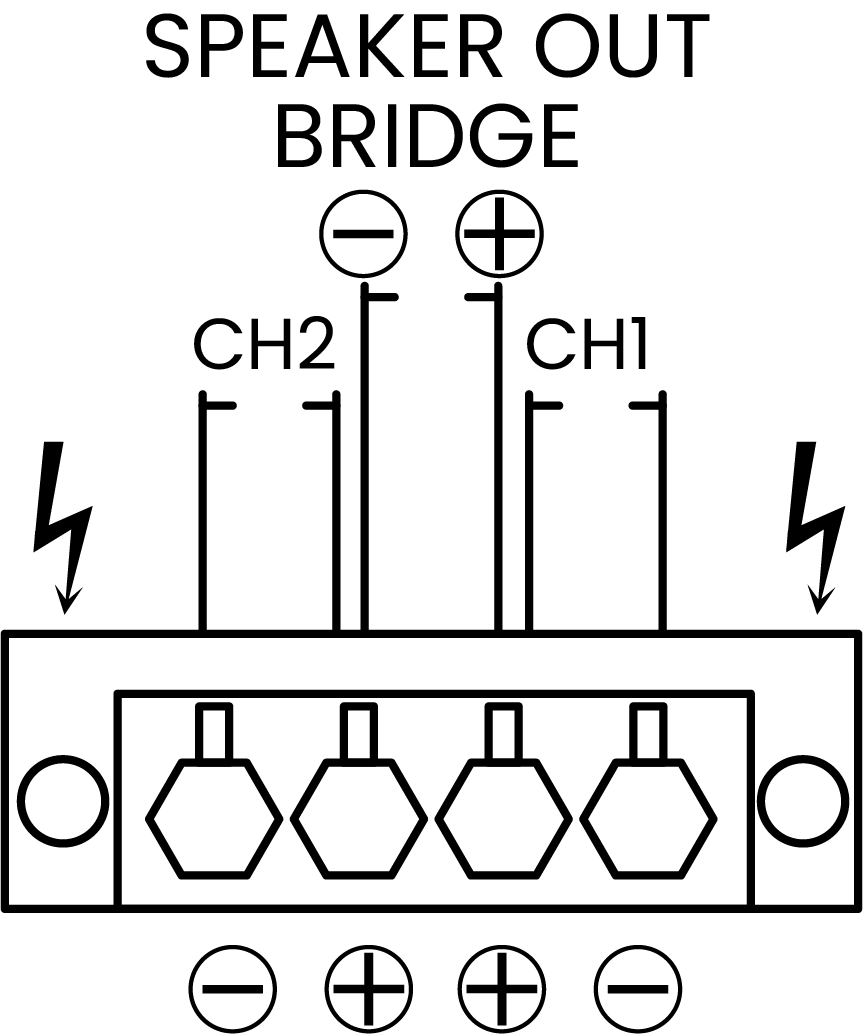Speaker connections
The Hybrid amplifier supports 70V, 100V, and 8Ω speakers. Set the individual channel outputs in the Inputs/Outputs tab.
Use any combination of speakers where the sum of the wattage does not exceed the rated wattage of the speaker output.
Caution: The system impedance must not be not less than 2Ω.
Visit the Episode outdoors brand page for landscape speaker design help.
Use 14 or 16 gauge stranded two-conductor speaker wire. Use burial rated wire for outdoor applications.
Connect the appropriate conductor to each screw terminal, observing correct polarity. Bridged markings are shown
|
Power output |
EA-HYB-AMP-2D-1200 |
EA-HYB-AMP-2D-2400 |
|
300W per channel @ 8Ω (1200W bridged) |
600W per channel @ 8 ohm (2000W bridged) |
|
|
600W per channel @ 4Ω (1200W bridged) |
1200W per channel @ 4Ω (2400W bridged) |
|
|
1200W per channel @2Ω |
1500W per channel @2Ω |
|
|
600W per channel @ 70V |
1200W per channel @70V |
|
|
1200W per channel @100V (230VAC only) |
2400W per channel @100V (230VAC only) |
Calculating amplifier power for 70V and 100V speakers
The system's total number of speakers and subwoofers is determined by the amplifier’s power. As the number of speakers increases, the available power to each decreases. Plan the system so that each speaker can receive the highest level of wattage available.
Only satellite speakers with 70V or 100V tap settings need to be calculated. 8Ω satellite speakers and subwoofers do not require calculation.
Pro Tip: Leave 20% of headroom, using only 80% of the rated power of the amplifier.
For the EA-HYB-AMP-2D-1200 this is 480W/channel.
For the EA-HYB-AMP-2D-2400 this is 960W/channel.
Load calculator
|
Speaker tap setting (A) |
CH 1 quantity (B) |
CH 2 quantity (C) |
CH 1 total (A×B) |
CH 2 total (A×C) |
|---|---|---|---|---|
|
3.75W |
||||
|
7.5W |
||||
|
15W |
||||
|
60W |
||||
|
|
Subtotal |
|||
|
Total watts |
||||
70V speaker wiring
Use burial-rated wire for all outdoor installations. 70V systems can use a smaller wire gauge. For example:
-
A 20 gauge cable run has an 11% power loss at 349.6 m (1,147').
-
An 18 gauge cable run can go up to 618.43 m (2,029').
-
A 16 gauge cable run can go up to 848.26 m (2,783').
8Ω speaker wiring
Use burial-rated wire for all installations. Below are common guidelines:
-
For wire runs up to 30.48 m (100'), use 16 gauge wire or larger.
-
For wire runs up to 60.96 m (200'), use 14 gauge wire or larger.
-
For wire runs up to 91.44 m (300'), use 12 gauge wire or larger.
Use the table below for more detailed information.
| Wire gauge | 8Ω speakers | 4Ω speakers (or two 8Ω speakers in parallel) | ||||
|---|---|---|---|---|---|---|
| 11% power loss | 21% power loss | 37% power loss | 11% power loss | 21% power loss | 37% power loss | |
| 12 | 88.87 m (291') | 189.59 m (622') | 412.09 m (1,352') | 43.59 m (143') | 100.89 m (331') | 115.82 m (680') |
| 14 | 57.61 m (189') | 122.83 m (403') | 267.26 m (867') | 28.04 m (92') | 60.66 m (199') | 133.20 m (437') |
| 16 | 35.66 m (117') | 68.58 m (225') | 168.55 m (553') | 18.59 m (61') | 39.01 m (128') | 84.73 m (278') |
| 18 | 26.52 m (87') | 59.13 m (194') | 123.44 m (405') | 12.50 m (41') | 28.04 m (92') | 61.26 m (201') |
Note: Using smaller wire gauges may reduce the overall performance.
